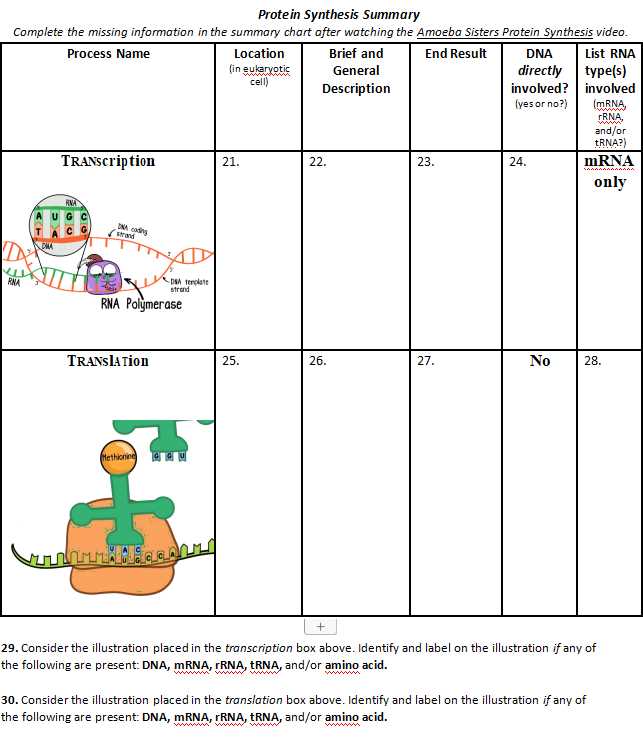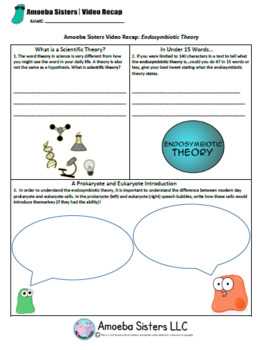
If you have recently watched the Amoeba Sisters video on mitosis, you might be wondering if there is an answer key available to help you understand the concepts better. Fortunately, we have created an answer key for you to reference, which will provide you with a deeper understanding of the video content and help you clarify any questions you may have.
In the Amoeba Sisters video, mitosis is explained as a process of cell division that allows for growth, repair, and asexual reproduction in organisms. The video takes you through each stage of mitosis, including prophase, metaphase, anaphase, and telophase, and provides clear visuals and explanations to help you grasp the key concepts.
The answer key we have prepared for you includes a detailed breakdown of each stage of mitosis, along with the major events that occur during that stage. It also provides additional information and explanations to ensure that you have a comprehensive understanding of the topic.
Whether you are using the Amoeba Sisters video as a study tool, preparing for an exam, or simply interested in learning more about mitosis, this answer key will serve as a valuable resource to support your learning and help you successfully navigate the world of cell division.
Amoeba Sisters Video Recap of Mitosis Answer Key
In the video recap by the Amoeba Sisters, they provide an answer key to help students understand the process of mitosis. Mitosis is a crucial process in cell division, where a parent cell divides into two identical daughter cells. Understanding the key steps of mitosis is essential for comprehending how cells grow and repair themselves.
The answer key provided by the Amoeba Sisters breaks down the process of mitosis into several stages. These stages include interphase, prophase, metaphase, anaphase, telophase, and cytokinesis. Each stage has specific characteristics that allow the cell to progress through cell division.
Interphase:
- This is the longest phase of the cell cycle.
- During interphase, the cell prepares to divide by growing and replicating its DNA.
- The DNA is in the form of chromatin, which looks like a jumbled mess under a microscope.
Prophase:
- The chromatin condenses into visible chromosomes.
- The nuclear envelope breaks down, and the nucleolus disappears.
- Spindle fibers begin to form from the centrosomes and attach to the chromosomes.
Metaphase:
- The chromosomes align at the equator of the cell, known as the metaphase plate.
- The spindle fibers attach to the centromere of each chromosome.
- This alignment ensures that each daughter cell will receive the same number of chromosomes.
Anaphase:
- The spindle fibers shorten, causing the centromeres to split.
- This separation pulls the sister chromatids apart, moving them towards opposite poles of the cell.
- Each separated chromatid is now considered an individual chromosome.
Telophase:
- The chromosomes reach the opposite poles of the cell.
- The nuclear envelope reforms around each set of chromosomes.
- The chromosomes begin to uncoil, returning to the form of chromatin.
Cytokinesis:
- In animal cells, a cleavage furrow forms, pinching the cell membrane to divide the cytoplasm.
- In plant cells, a cell plate forms in the middle of the cell, eventually becoming a new cell wall.
- The end result of cytokinesis is two genetically identical daughter cells.
By understanding the key steps and characteristics of mitosis provided in the Amoeba Sisters’ answer key, students can comprehend how cells divide and contribute to the growth and development of living organisms.
What is Mitosis?

Mitosis is a crucial process in the life cycle of a cell, where a cell divides into two identical daughter cells. This process is essential for growth, development, and repair of tissues in multicellular organisms. Mitosis allows organisms to maintain a constant number of cells by ensuring that each newly formed cell receives a complete set of genetic information.
During mitosis, the cell undergoes a series of events that result in the division of the nucleus and the separation of the replicated chromosomes. The process can be divided into four main stages: prophase, metaphase, anaphase, and telophase. In prophase, the chromosomes condense and become visible. The nuclear membrane also breaks down, allowing the chromosomes to move freely. In metaphase, the chromosomes line up along the center of the cell. During anaphase, the sister chromatids separate and move towards opposite poles of the cell. Finally, in telophase, a new nuclear membrane forms around each set of chromosomes, and the cell begins to divide.
The purpose of mitosis is to ensure that each resulting daughter cell has a complete set of chromosomes and genetic information identical to the parent cell. This is important for the growth and development of an organism, as well as for tissue repair. Without mitosis, cells would not be able to divide and multiply, leading to a lack of new cells and impaired tissue regeneration.
Overall, mitosis is a highly regulated process that plays a vital role in the maintenance and growth of living organisms. It ensures the accurate distribution of genetic material and allows for the formation of new cells. Understanding the intricacies of mitosis is essential for comprehending the basic principles of cell biology, genetics, and development.
Steps of Mitosis
Mitosis is the process by which a cell divides and produces two identical daughter cells. It consists of several distinct steps, each of which plays a crucial role in ensuring the accurate distribution of genetic material. Understanding the steps of mitosis is essential for comprehending how cells replicate and maintain their genetic integrity.
1. Interphase:
Interphase is the longest phase of the cell cycle, accounting for about 90% of the total cycle time. During this phase, the cell grows, carries out its normal functions, and duplicates its DNA. Interphase is divided into three distinct subphases: G1 (cell growth and preparation for DNA replication), S (DNA replication), and G2 (cell growth and preparation for mitosis).
2. Prophase:
Prophase is the first stage of mitosis and marks the beginning of cell division. During this phase, the chromatin condenses into visible chromosomes, the nuclear envelope breaks down, and the centrosomes move to opposite poles of the cell. Microtubules called spindle fibers begin to form and attach to the chromosomes at specialized structures called kinetochores.
3. Metaphase:

During metaphase, the chromosomes align along the equator of the cell, known as the metaphase plate. The spindle fibers attached to the kinetochores help to position and align the chromosomes precisely in the center. This alignment ensures that each daughter cell receives an equal and complete set of chromosomes during cell division.
4. Anaphase:
Anaphase is characterized by the separation of sister chromatids. The spindle fibers attached to the kinetochores shorten, pulling the chromosomes apart and towards opposite poles of the cell. This movement ensures that each daughter cell receives one copy of each chromosome.
5. Telophase:

In telophase, the chromosomes reach the opposite ends of the cell, and new nuclear envelopes begin to form around them. The chromosomes begin to decondense back into chromatin, and the spindle fibers disassemble. Two separate nuclei start to form, marking the end of mitosis.
6. Cytokinesis:
Cytokinesis is the final stage of cell division, which completes the process of generating two daughter cells. During cytokinesis, the cytoplasm of the cell is divided, and two separate cell membranes are formed. In animal cells, a cleavage furrow forms and gradually deepens until the cell is pinched in two. In plant cells, a cell plate is formed in the middle, which eventually develops into a new cell wall.
Prophase: The Beginning of Mitosis
In the process of cell division, mitosis is a crucial stage where the cell’s nucleus divides into two identical nuclei. Prophase is the initial stage of mitosis, characterized by significant changes occurring within the nucleus and the surrounding cytoplasm.
During prophase, the chromatin inside the nucleus begins to condense and coil tightly, forming visible chromosomes. Each chromosome consists of two identical sister chromatids, connected at a region called the centromere. The nuclear envelope starts to break down, allowing the chromosomes to become more accessible.
- Chromatin Condensation: In prophase, the chromatin fibers become more tightly packed, undergoing condensation to form visible chromosomes. This structural change is essential for the accurate distribution of genetic material during cell division.
- Nuclear Envelope Breakdown: The nuclear envelope, which separates the nucleus from the cytoplasm, begins to disassemble during prophase. This breakdown allows the chromosomes to interact with the other components of the cell and ensures the smooth progression of mitosis.
Furthermore, microtubules called spindle fibers start to form in prophase. These fibers extend from structures called centrosomes located at opposite poles of the cell. The centrosomes move towards the opposite ends of the cell, aiding in the organization of the spindle fibers between them. These fibers will play a critical role in moving and aligning the chromosomes during later stages of mitosis.
Overall, prophase sets the stage for mitosis by preparing the chromosomes for separation and facilitating the formation of the spindle apparatus. This phase marks the beginning of a complex series of events that ultimately ensure the accurate distribution of genetic material between two daughter cells.
Metaphase: Alignment of Chromosomes
In the process of mitosis, metaphase is a crucial stage where the chromosomes align in the center of the cell. During this stage, the nuclear envelope disassembles, and the chromosomes condense, becoming visible under a microscope. The microtubules of the cell’s cytoskeleton attach to the chromosomes at specialized structures called kinetochores.
The alignment of chromosomes during metaphase is essential for the accurate separation of DNA into the daughter cells. The microtubules exert tension on the chromosomes, creating a balance between the forces that pull in opposite directions. This ensures that each daughter cell receives the correct number of chromosomes during cell division.
The alignment of chromosomes is facilitated by the spindle apparatus, which consists of microtubules and associated proteins. These microtubules extend from opposite poles of the cell and attach to the chromosomes at their kinetochores. As the microtubules shorten or lengthen, they move the chromosomes toward the center of the cell, aligning them along an imaginary plane called the metaphase plate.
In conclusion, the alignment of chromosomes during metaphase is a highly regulated process that ensures the accurate distribution of genetic material to the daughter cells. This alignment is facilitated by the spindle apparatus and the tension exerted by the microtubules. Understanding the mechanisms behind metaphase alignment is crucial in studying normal cell division and identifying potential abnormalities that may lead to diseases like cancer.
Anaphase: Separation of Sister Chromatids
In the process of mitosis, anaphase is a vital stage where the sister chromatids, which are identical copies of DNA, are separated. This stage is crucial for the proper distribution of genetic material to daughter cells. The separation of sister chromatids ensures that each daughter cell receives the correct amount of genetic material and maintains the integrity of the organism’s DNA.
During anaphase, the protein structures known as kinetochores, which are located on the centromere region of each sister chromatid, play a crucial role. The kinetochore microtubules, part of the cell’s cytoskeleton, attach to the kinetochores and begin to exert tension. This tension helps to pull the sister chromatids apart and towards opposite poles of the cell. As the kinetochore microtubules shorten, the sister chromatids are gradually separated and move away from each other.
The separation of sister chromatids is a highly regulated process. The cell ensures that each chromatid is attached to both poles before the separation occurs. This mechanism helps prevent errors in chromosome segregation, such as nondisjunction, which can lead to genetic abnormalities. The timing and coordination of anaphase are regulated by various molecular checkpoints to maintain the accuracy and fidelity of cell division.
In summary, anaphase is the stage of mitosis where sister chromatids are separated. The kinetochore microtubules exert tension to pull the sister chromatids apart and towards opposite poles of the cell. This process is tightly regulated to ensure accurate distribution of genetic material to daughter cells and maintain the integrity of the organism’s DNA.
Telophase: Nuclei Form and Cytokinesis Begins
Telophase is the final stage of mitosis, characterized by the formation of two new nuclei and the beginning of cytokinesis. During this stage, the chromosomes arrive at the opposite poles of the cell and start to decondense. Nuclear envelopes, which had disappeared during prophase, begin to reassemble around each set of chromosomes.
In telophase, the spindle fibers dissolve and the nuclear membranes start to form. As the nuclear membranes reform, they enclose the separated chromosomes and create two distinct nuclei. At this point, the cell is on the verge of dividing into two separate daughter cells.
The physical separation of the two nuclei marks the end of mitosis. However, before complete cell division occurs, cytokinesis takes place to physically separate the cytoplasm and other cell contents into two daughter cells.
Cytokinesis begins during telophase and is the process by which the cytoplasm divides. In animal cells, a cleavage furrow forms as a series of proteins gather in a ring along the cell equator. These proteins contract, causing the cell membrane to pinch inward until the cell divides into two daughter cells.
On the other hand, in plant cells, a cell plate forms during cytokinesis. Vesicles containing cell wall components come together and fuse, creating a structure called the cell plate. The cell plate gradually develops into a new cell wall, separating the daughter cells.
In summary, telophase is characterized by the formation of two new nuclei and the beginning of cytokinesis. The reformation of nuclear envelopes encloses the separated chromosomes and marks the end of mitosis. Cytokinesis then divides the cytoplasm, either through a cleavage furrow in animal cells or a cell plate in plant cells, resulting in the formation of two daughter cells.